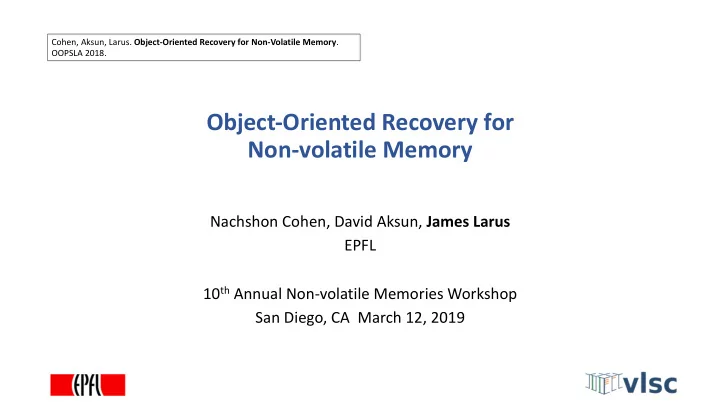

Cohen, Aksun, Larus. Object-Oriented Recovery for Non-Volatile Memory . OOPSLA 2018. Object-Oriented Recovery for Non-volatile Memory Nachshon Cohen, David Aksun, James Larus EPFL 10 th Annual Non-volatile Memories Workshop San Diego, CA March 12, 2019
Overview • Prior NVM recovery mechanisms are incomplete • Your carefully stored, consistent data may be unusable • Object-oriented recovery • llvm extension to support complete recovery James Larus 2
NVM Lifecycle 2. NVM must record a 1. Code accesses consistent memory state Run Terminate NVM with load and before termination, store instructions planned or unexpected Recovery 3. Ensure NVM state is consistent in the environment in which execution restarts James Larus 3
Recovery Problems 1. Non-persistent data 2. NVM remapping 3. Code remapping James Larus 4
1. Non-Persistent Data in NVM Network socket referenced from NVM is valid in current environment NVM James Larus 5
6
Environment Can Change on Restart Network socket is no longer usable NVM James Larus 7
Environmentally-Specific Data • Network sockets Lesson 8 : Initialization of semantically nonpersistent data colocated with persistent data is tricky. Programmers frequently find it • Locks convenient to co-locate nonpersistent data in persistent objects . • Process and thread IDs --- Persistent Memcached: Bringing Legacy Code to Byte-Addressable Persistent Memory , HotStorage ‘17. • File handles • … • Common practice to store [pointers to] these objects in NVM • Fast access • Must restore / reinitialize during recovery • Traverse all objects in NVM (= GC) James Larus 8
2. NVM (Re)Mapping base = mmap(0 x 1000, …, nvm_fd); B A 0 x 1000 0 x 1200 James Larus 9
10
Remapped To Different Address base = mmap(0 x 1000, …, nvm_fd); But, kernel may mmap to a different address B A 0 x 2200 0 x 2000 0 x 1000 James Larus 11
“If addr is not NULL, then the kernel takes it as a hint mmap about where to place the mapping.. -- MMAP(2) man page • Always map to specified virtual address? NO • OS upgrade • NVM grows/shrinks • Execution under debugger/profiler/etc. • Earlier actions during recovery • Mapping in several NVM segment • … James Larus 12
3. Code and Literal Pointers • Function pointers and virtual pointers are also execution specific • Address Space Layout Randomization (ASLR) • C++ objects contain method pointers • Object may not be well formed after restart James Larus 13
Published Solutions Data is not durable if it cannot survive system changes • Forbid NVM to DRAM pointers [ASPLOS’11] • Impractical in real systems [HotStorage’17] • Ad-hoc, specific solutions • Generational locks [ASPLOS’11] • Self-relative pointers [NVML, NVM-Direct] • Comment code (and hope someone reads it) • Custom (re)initialization code James Larus 14
NVM Reconstruction • Compiler support for object-level recovery • Recovery procedure for each object in NVM • Ensures that object is well- formed after recovery • Transparent to application James Larus 15
llvm Language Extension Standard pointer (no relative addresses) struct …{ Zero on restart void *CurrAllocAddr_; transient pthread_mutex_t lock; Custom initialization code reconstructor (node *n){ pthread_mutex_init(&n->lock); } void addChild(long k){ left = pnew node(k); Allocate in NVM James Larus 16
NVM Reconstruction Workflow Executable Code DRAM llvm* Program Reconstructor Runtime NVM NVM Object Metadata Clang/LLVM plugin Extend objects with type information Collect metadata Runtime Records runtime information, e.g., mapping address Allocates header for each durable object James Larus 17
Reconstruction After Failure During recovery Use type information from previous execution Compute address space delta per page For each live object: Zero transient fields Rebase NVM pointers Fix code pointers Invoke user-provided reconstructor James Larus 18
Lazy Reconstruction Initially: memory protect NVM region On page-fault: For each live object in page Apply system reconstruction Zero transient fields Fix NVM pointers, code pointers Apply User-provided reconstruction James Larus 19
Performance Measurements: Atlas • Applied NVM-Reconstruction to Atlas [Chakrabarti 2014] • Support for transient fields, different mapping addresses, etc. • Negligible runtime cost • Measured simple Key-Value Store • Recovery time: up to 200ms/GB, depends on number of items James Larus 20
Code Change Measurements: Echo KV Store • Incorporated NVM-Reconstruction into Echo Key-Value Store • Original code: 22,503 SLOC, no recovery • NVMReconstructor: added 214 SLOC, full recovery realloc reconstr pnew pdelete transient total extra uctor Added 214 38 68 25 19 64 SLOC James Larus 21
Reconstruction Test Environment: 1. gcc –O0 2. Add field to each class 3. mmap @ 3 x 2 40 Environment: 1. gcc –O3 2. Original classes 3. mmap @ 2 40 James Larus 22
Conclusions • Execution environment may differ after restart • Need to recover execution-specific data and adjust for environment changes • NVM-Reconstruction: system-level approach for object-level recovery • Transient fields, virtual address pointers, custom reconstructor functions • Low overhead • Easy to use Questions? James Larus 23
Recommend
More recommend